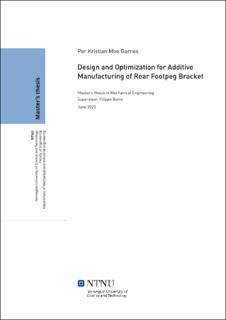| dc.contributor.advisor | Berto, Filippo | |
| dc.contributor.advisor | Rølvåg, Terje | |
| dc.contributor.author | Garnes, Per Kristian Moe | |
| dc.date.accessioned | 2021-09-24T18:14:09Z | |
| dc.date.available | 2021-09-24T18:14:09Z | |
| dc.date.issued | 2020 | |
| dc.identifier | no.ntnu:inspera:60273394:20963235 | |
| dc.identifier.uri | https://hdl.handle.net/11250/2781677 | |
| dc.description.abstract | I denne masteroppgåva blir det sett på ein Ducati Multistrada 1260 sine bakre fotstøttar, og korleis desse kan bli optimalisert med bruk av topologioptimalisering og additiv tilverking. Hovudmålet var å redusere vekt utan at det gjekk utover den strukturelle stivleiken til komponenten. Oppgåva presenterar utviklingsprosessen frå analysering av det nåverande fotstøtte oppsettet, til endeleg FEM validifisering av det nye designet.
Teori kapittelet tar for seg hovudtemaa strukturelloptimalisering og additiv tilverking, med deira fordelar og ulemper relatert til fotstøtte oppsettet. Eit design domene blei konstruert, basert på geometrien og innfestningane til det originale fotstøtte oppsettet gitt av Ducati. Hovudlasttilfellet på 1700N på fotstøtta gitt av Ducati blei kombinert med eit ekstra lasttilfelle, beståande av 200N laster i dei ekstra innfestningane til bagasje. Dette var for å forsikre at desse områda hadde tilstrekkeleg geometri, sida dei ville blitt fjerna av topologioptimaliseringa utan desse lastane. Programvara Siemens NX blei brukt til topologioptimaliseringa, basert på ei samanlikning med Fusion 360 og Abaqus Tosca. Oppsettet i NX er presentert i detalj for både topologioptimaliseringa og konstruksjonen av CAD solid model. Topologioptimaliseringa brukte vektmål frå 550g til 200g. Resultata som kom ut av dette var at den endelege komponenten har eit potensiale for vektreduksjon. Det endelge vektmålet blei bestemt å vere 350g, og blei køyrd med ein overhengsvinkel begrensing i forhold til printeretning. Ein solid model blei konstruert i NX, basert på resultata.
Den første iterasjonen av det endelege designet klarte seg dårleg i samanlikning med den originale braketten i FEM analyse. Den hadde fleire områdar som kryssa både flytegrensa og utmattingsgrensa. Braketten sitt design blei gått over basert på desse resultata, der geometrien blei endra med blant anna endring av diverse tverrsnitt for å redusere spenningane. Det endelge designet har ei vekt på 382g, som er 30% lågare enn original delen sin vekt på 536g. Den yter også tilstrekkeleg styrkemessig i forhold til original delen etter desse geometriske endringane. | |
| dc.description.abstract | This master thesis is analyzing how topology optimization and additive manufacturing could be used on the Ducati Multistrada 1260’s rear footpeg assembly. The main goal was to reduce the weight without compromising the structural integrity and stiffness of the component. The thesis presents the entire design process of the new footpeg bracket, from analyzing the current original equipment manufacturer (OEM) bracket to a final FEM validation of the new design.
The theory chapter of the thesis presents the main topics structural optimization and additive manufacturing with its pros and cons in accordance to the footpeg bracket. A design space was created based on the geometry and constraints of the OEM footpeg assembly given by Ducati. The main load case of 1700N at the footpeg was given by Ducati, and an extra load case of 200N luggage loads was added to ensure structural integrity in the accessory luggage mounts. This is due to these points being removed in the topology optmization without these loads. AlSi10Mg was chosen as the material for the bracket. The software used for the topology optimization was Siemens NX, based on a comparison against Abaqus Tosca and Fusion 360. NX’ setup is presented in detail both for the topology optimization and the CAD redesign tools. Weight targets from 550g to 200g were utilized in the topology optimization. The results from the topology optimizations showed that the final component had a potential for weight reduction. Self-supporting constraints regarding print direction were added to the chosen weight target, and the resulting geometry was recreated to a solid in NX.
The first iteration of the final design did not fare well in benchmarking against the OEM component. It had several spots exceeding both yield strength and fatigue strength. The bracket’s design was revised based on these results, by adjustment of cross-sections and other geometry. The final design iteration ended up with a weight of 382g, resulting in a weight reduction of about 30% to the OEM bracket’s 536g. It also performed fine structurally when benchmarking against the OEM bracket, after the final tweaks of the design. | |
| dc.language | | |
| dc.publisher | NTNU | |
| dc.title | Design and Optimization for Additive Manufacturing of Rear Footpeg Bracket | |
| dc.type | Master thesis | |
